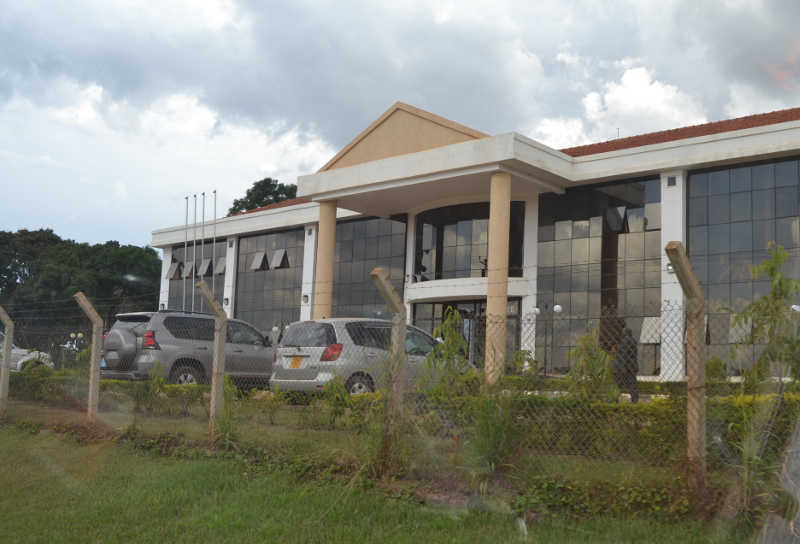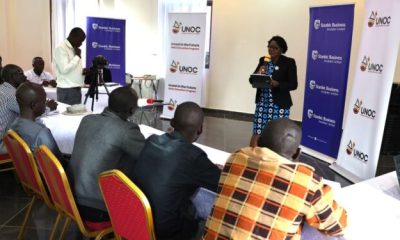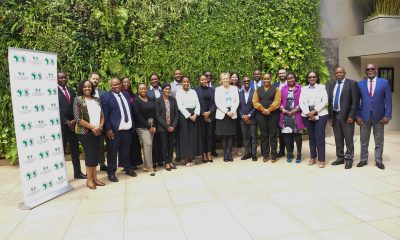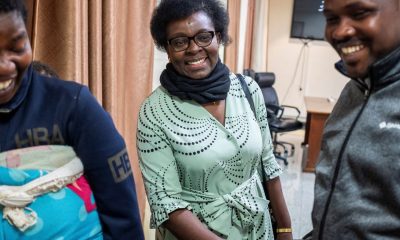human traffickingFeatures
Uganda takes major strides in biotech capacity development
Move seen as a major step to help country launch itself into the bio-economy

A delegation of business persons from Tanzania was in Uganda in 2017 to tour Uganda’s biotechnology facilities. They marveled at the speed with which Uganda has built her capacity in biotech research
Uganda has taken major steps forward in building her biotechnology and biosafety capacity especially over the past ten years in major areas such as human capital development, infrastructure as well as in the systems and policy arena.
A yet to be published study by Dr. Barbara Zawedde Mugwanya and colleagues, on Readiness for Environmental Release of Genetically Engineered Plants in Uganda, reveals that the country currently has over 180 scientists with a minimum of a Masters degree actively working as biotechnologists and plant breeders.
A Status of Affairs report by the International Food Policy Research Institute (IFPRI) and the African Development Bank had found that by 2007, Uganda had only 12 biotechnologists and plant breeders with a minimum of a Masters degree.
This represents an increase of more than 89 percent in just one decade, and constitutes a phenomenal increase in Uganda’s human resource capacity to develop and manage her biotech agenda. The study findings led Dr. Zawedde and colleagues to conclude that Uganda is ready for the environmental release of Genetically Modified crops.
Uganda’s enhanced capacity could put to rest concerns by critics and doubters that Uganda’s agricultural agenda will fall into the hands of foreign multinational companies that seek to dominate the country’s seed industry.
Indeed, as seen from the research already being done, Uganda is leading the rest of Africa with up to 17 trials of genetically improved crops that are not so much for commercial interests but rather for the purpose of ensuring food security for the country’s rapidly growing population.
Although majority of the scientists are currently working in the public agricultural research arena, striving to develop improved crops and animal breeds against major challenges such diseases and unfavourable weather and soil conditions, there is a growing number of biotech experts seeking to use their skills in the fields of human medicine, and the environment.
The achievement has been described as a major break from that past and puts the country in a much better position to take charge of her development agenda with the capacity to develop new solutions to farmers’ challenges while also being able to evaluate the potential adverse effects of imported foods or seeds to safeguard already existing ones.
It is also thanks to the establishment of biotechnology courses in at least nine universities.
Caveat
While the development is in many ways commendable, some observers are cautiously optimistic about Uganda’s capacity. Part of the caution arises from huge need for more researchers to be able to effectively steer the bio-economy, as well as what many consider as inadequate funding by the government towards human capital development.
Arthur Makara, the Executive Director of Science Foundation for Livelihoods and Development (SCIFODE), observes for example, that Uganda’s available technical capacity is only sufficient for the start (commercialization of GM crops) but is inadequate to facilitate a well-functioning biotechnology revolution.
“We need more than 1200 scientists at that level if we are to celebrate that we have sufficient human capacity,” Makara says.
Makara warns, however, that the delays in enacting a law to commercialize biotechnology crops, represents a stumbling block in the allocation of resources for further capacity development.
“Without an enabling law, you don’t have the legal basis to allocate resources for capacity development,” Makara says. Besides, as Dr. Zawedde points out in their study, enactment of a law would help product developers to ‘test the system’ through practice.
Donor-dependence
Herbert Oloka, the Coordinator of the Programme for Biosafety Systems (PBS) also observes that Uganda’s human capacity development, with the exception of undergraduate programmes, has largely been donor funded. Oloka, who was part of Dr. Zawedde’s study team in assessing Uganda’s preparedness for release of GM crops, says that they found that Uganda government’s contribution in training of Masters level scientists was only 3 percent, the rest of the funding was provided by donors.
Origins
Uganda started her cutting-edge modern biotech research in 2003 with the inauguration of National Biotechnology Centre at Kawanda. Initial research started with the development of a banana variety that is resistant to the Black Sigatoka disease, following futile attempts by scientists to use conventional means to cure the disease. More groundbreaking research has since been carried out on Uganda’s staple crops including Cassava, Irish Potatoes, Sweet Potatoes and Vitamin A bio-enhanced banana. So far much of the research has proved successful, and in some instances, beyond expectations.
For example the use of an ubiquitous soil bacteria Bacillus Thuringiensis (Bt) in the control of Maize Stem borers, proved by as much as 80 percent successful in the control of an even more dangerous Fall Armyworm that has ravaged maize across Uganda.
The choice of crops approved for research, according to Dr. Charles Mugoya, the Chairman of the National Biosafety Committee (NBC) is greatly influenced by the country’s development needs, guided by the Uganda Vision 2040, the Uganda National Council for Science and Technology Act (UNCST) of 1990, as well as the Ministry of Agriculture’s Strategic Plan.
Low levels of Vitamin A and Zinc in staple foods such as Matooke, Maize flour and Cassava, are considered as major sources of malnutrition and obstacles for the mental and physical development of millions of children in Uganda.
The Uganda Demographic and Health Survey (UDHS) 2016, shows that an overwhelming 28 percent of children in Uganda under five years suffer from malnutrition, with Vitamin A, Zinc and other micro-nutrient deficiencies being the major contributors to these sad statistics.
The establishment of the National Biosafety Committee (NBC), under the UNCST Act, as the clearing house for all biotech work, has further helped to build a critical mass of keen regulators.
And over the past twenty years of the UNCST, Uganda has accumulated considerable capacity in regulation with over 90 people now having worked as regulators.
Mugoya, says Uganda’s biosafety regulatory expertise is acknowledged by many governments in the eastern African region.
Mugoya points out: “I have been contracted to establish the biosafety system in Rwanda, Malawi and Ethiopia. This attests to the level of respect that our neighbours attach to our expertise.”
Uganda’s enhanced capacity goes beyond the human capital development. Over the past decade, the country has put in place a robust institutional, policy and legal regime to direct the safe development of the technology that is considered essential to Uganda’s agricultural sector.
In 2008, Uganda approved the National Biotechnology and Biosafety Policy as the guiding vision for the use of the science in addressing crop and livestock production challenges. The policy stipulates that biotechnology would only be used where other conventional breeding techniques fail.
In realisation of the objectives and goals of the policy, a number of state institutions are co-opted on the Biosafety Committee to guide its implementation. These include the Ministry of Water and Environment, the Ministry of Health, and the Ministry of Trade and Industry through the Uganda National Bureau of Standards (UNBS).
Infrastructural development
Despite the government’s lukewarm approach towards legalising the commercialisation of successful GM crops, it has allocated resources towards salaries of researchers as well as allocating land and money to facilitate research work in the National Agricultural Research Organisation (NARO)’s extensive research network.
The country has built more than ten biotechnology laboratories and hosts various regional centres of excellence. Uganda currently serves as a centre of excellence for Cassava research under the Virus Resistant Cassava for Africa (VIRCA) serving Uganda, Nigeria and Kenya.

The Cassava centre is a recent addition to Uganda’s growing research infrastructure, thanks to support from donors
Uganda’s Biosciences Research and Training Centre located at Namulonge has helped to train hundreds of scientists and policy makers in biotechnology.
The Entebbe-based National Animal Genetic Resources Centre and Databank (NAGRC & DB) , recently named as a centre of excellence in animal genetic research in the region and Makerere University’s Centre for Crop Improvement, based at Kabanyoro have added clout to the country’s technical capacity in the field.
Idle capacity
Despite Uganda’s enviable progress, there is growing concern that without an enabling law that allows innovations to reach farmers, the accumulated technical capacity will be lost as experts move to other countries for greener pastures.
The IFPRI report was categorical on this when it stated that: “The impact of new products resulting from such research is increasingly hampered by an inability of traditional systems to adjust delivery requirements mandated by those new innovations, thereby compromising the impacts of innovations on the lives of poor farmers.”
Herbert Oloka, while speaking at a recent BioCafe hosted by SCIFODE, cautioned that recent steps by Kenya and Ethiopia to accelerate the release of Biotech crops could undermine Uganda’s comparative and competitive advantage in the production of some biotech crops.
“Our food exports to the region could very soon become less competitive if we continue producing at high cost when our neighbours have lowered their costs of production by using less pesticides and higher yielding or climate resilient crops,” Oloka warned.
Comments



























